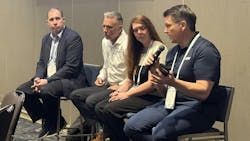ACCA Panel Advises to ‘Stay the Course’ on Refrigerant Rules
GREATER AUSTIN, Texas — When asked if their companies were rolling with the changes and stocking primarily A2L refrigerants, roughly 78% of attendees said no, they were not primarily stocking A2Ls. This live polling took place during a Codes and Coffee webinar breakout session about the EPA phasedown of HFC refrigerants and the market for A2L products at ACCA 2025. Roughly 15% reported being unsure, and a little over 7% reported they were primarily stocking A2L refrigerants.
When asked if they were well stocked with R-410A, 47% responded they were not well stocked, while nearly 37% reported they were well stocked, and nearly 16% responded as unsure.
Christian Pyles, TSS Americas Region — marketing leader for Chemours; John Maiorana, product support manager, Arkema/Forane; Kate Houghton, senior vice president of sales and marketing, Hudson Technologies; and Chris Forth, vice president of regulatory, codes and environmental affairs, Ducted Systems Division, Johnson Controls, all participated in a panel discussion about the AIM Act and what contractors should know.
“All three parts of the AIM Act have either a legal challenge or legislative challenge right now,” Forth explained. “Whether it's the allocation being production or imports, that's got a legal challenge. And then, there's also the legal challenge with the technology transition. Then, there's a legislative proposal to use the Congressional Review Act to basically cancel the Refrigerant Management Rule. There's a lot of rampant discussion like, ‘Hey, Trump's going to roll all this back. Just sit tight.’ There's a lot of things that would need to happen. It can't just be canceled, can't just be stopped, right? There'll have to be some additional activities.:
Forth called the Refrigerant Transition Rule probably the most consequential of all, as it just took effect Jan. 1 of this year. “That’s the one with litigation from the National Groceries Association, Food Marketplace Incorporated — they’ve challenged the rule based on lack of availability of products, not in the market cost to small grocers. It’s already been argued, we’re just waiting on a decision. There’s a number of different scenarios the courts could look at, and none of them will the rule being immediately cancelled.”
There are a number of outcomes, one of which being the rule goes back to the EPA to start over, Forth noted. “As of now, the transition’s still on — it’s not changing overnight,” he said.
As an OEM, Johnson Controls has converted all of its assembly lines over from R410A to R454B in the U.S., and R32 in facilities elsewhere, Forth noted.
Houghton addressed the Congressional Review Act during the breakout session.
“The Refrigerant Management Rule fell into that time period where the current administration could look back and review legislation that was passed in a particular timeframe,” she said. “There are quite a number of pieces of legislation that were filed under the Congressional Review Act. [Last month,] the list of the first series of legislation priorities to be reviewed under the Congressional Review Act was published, and the AIM Act, subsection H, was not on that list. So we live a little bit in a time of uncertainty, but that doesn’t mean they can’t get to it or that they won’t get to it. Right now, it’s not a priority.”
Houghton agreed with Forth, saying that, right now, it’s about staying the course.
“The Refrigerant Management Rule, leak detection — all the things about reclaimed refrigerant and all the elements of subsection H are in place, and we need to keep moving forward as if that’s the case as well for the foreseeable future,” she said.
A2L Availability
Attendees questioned the panel whether A2L refrigerant and OEM equipment would be available to them for the coming cooling season.
Pyles noted that A2L cylinder availability is the big deal.
“Large distributors are ordering hundreds of pallets of this stuff, so now we have to determine who gets it, who doesn’t get it,” he explained. “We have to sort it out. We know the whole industry across the country needs this stuff. So we’re going to distribute it strategically to get it out so that every contractor has some instead of guys just banking it in their warehouses. But we should be coming into summertime with cylinders for everybody.”
Forth reminded everyone that there is still a lot of R-410A in the market. “We’re three and a half months into this thing. We’re in the ramp up phase, and I think a lot of the supply houses, our distributors, and our factory direct are just starting to sell more of the A2L, R454B and R-32 products.”
Pyles added this transition is not just for the OEMs.
“The distributors are making their own business decisions, and they’re gambling whether they should stock up on R-410A and run through the summer and transition in February,” he said. “Each distributor is making their own business decisions as to when they're going to transition. Just like a lot of contractors are also making their own business decisions. Are they going to jump into the pool, or are they going to hang on to R-410A as long as they can? So you may be running into a distributor who has decided to wait to transition.”
“Today, it [R-410A equipment] is not being made,” Forth added. “Whatever’s made, it’s working its way through the pipeline. There are parts of the country that are transitioning earlier than later. It depends on what your distributors decided to do from their product strategy. This is a normal transition, guys. We did this back in 2010, right? This is the kind of thing where we built some inventory for today, and it’s going to take a while to work through it. But here's the key for today's session, R-410A’s got a finite life — whether it be the refrigerant or my products as an OEM, it's not being made anymore. So it's just a matter of ramping down, ramping up, whatever that slope is.”
About the Author

Nicole Krawcke
Nicole Krawcke is the Editor-in-Chief of Contracting Business magazine. With over 10 years of B2B media experience across HVAC, plumbing, and mechanical markets, she has expertise in content creation, digital strategies, and project management. Nicole has more than 15 years of writing and editing experience and holds a bachelor’s degree in Journalism from Michigan State University.
